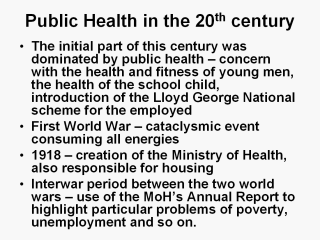 |
The first 14 years of this
century were dominated in public health, by concern with health and fitness
of young men, the health of the schoolchild, and the introduction of the
Lloyd George National Insurance scheme for the employed. The First World War
was a cataclysmic event, and all energies appeared to be consumed in its
pursuit. There was little concern for what would happen after the end of the
War; in contrast to the 1939-45 conflict, and attempts to provide equitable
food distribution were rudimentary, and only introduced towards the end of
the War. 1918 was marked by the creation of a Ministry of Health, also
responsible for housing. The concerns for public health in the inter-war
period were largely on the effects of poverty and unemployment on health,
linked to attempts to improve housing and nutrition. Organizationally, this
period saw the change from the Poor Law Administration of institutions, to
Local Authorities and the use of the MoH’s Annual Report, to highlight
particular problems of unemployment, poverty, and so on. |
